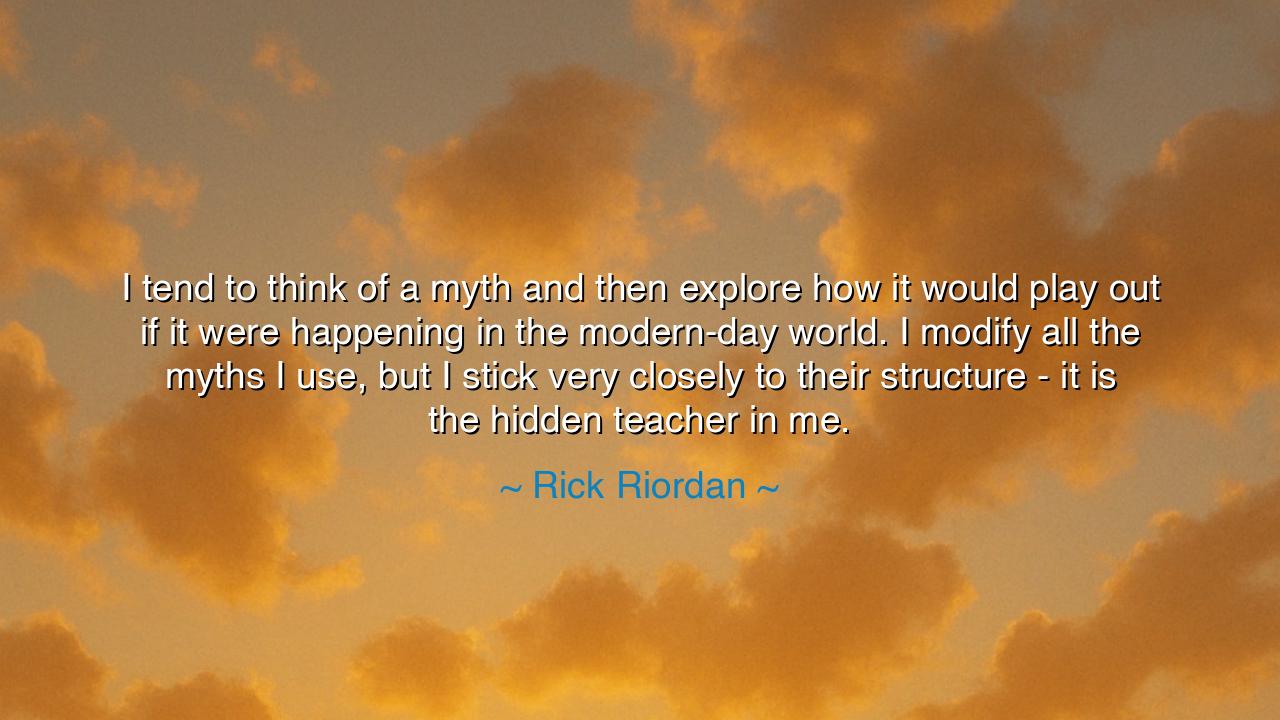
I tend to think of a myth and then explore how it would play out
I tend to think of a myth and then explore how it would play out if it were happening in the modern-day world. I modify all the myths I use, but I stick very closely to their structure - it is the hidden teacher in me.






When Rick Riordan said, “I tend to think of a myth and then explore how it would play out if it were happening in the modern-day world. I modify all the myths I use, but I stick very closely to their structure – it is the hidden teacher in me,” he revealed not only his craft as a storyteller but also the timeless role of myths in guiding humanity. His words remind us that myths are not relics of a forgotten past but living vessels of wisdom. They may wear the clothing of gods and monsters, but beneath those garments lie truths about courage, betrayal, love, pride, and destiny. By reshaping these myths for the modern age, Riordan shows that their essence is eternal, that their structures are strong enough to bear the weight of every generation’s struggles.
The origin of Riordan’s approach lies in his years as a teacher of history and literature. In his classroom, he encountered restless children who found mythology more alive than dusty dates and names. He discovered that myths spoke to them because they were stories first, lessons second—dramas of flawed heroes who must learn, of quests that mirrored the trials of human life. In carrying these tales into his novels, Riordan did not abandon the role of a teacher; instead, he transformed it. The “hidden teacher” within him uses narrative not to lecture, but to invite. He hands his readers a myth not as an artifact to examine, but as an adventure to live.
The ancients themselves understood this power. The Greeks told the story of Prometheus, who defied the gods to give mankind fire. For them, the myth was more than entertainment: it was a meditation on ambition, rebellion, and the price of progress. The Norse spoke of Ragnarök, the end of the world, not only as doom but as renewal, a reminder that even in destruction there is the promise of rebirth. Riordan, by translating these ancient structures into the modern world, keeps alive the ancient purpose of myth: to teach through wonder.
History shows us other keepers of myth who reshaped old tales for new times. Consider Homer, who took the fragments of Greek oral tradition and gave them immortal form in the Iliad and the Odyssey. His audiences already knew the characters and legends, but he wove them into epics that spoke to the identity and destiny of his people. In much the same way, Riordan modifies his myths but clings to their structure, ensuring that while the details may change, the eternal lesson is preserved. For as he himself notes, the structure is the teacher, the framework within which truth is hidden.
The meaning of Riordan’s quote is thus a revelation about storytelling itself. To modify a myth is to clothe eternal truth in garments suited for the age. To preserve the structure is to honor the ancient architects who built these truths into the very bones of narrative. The hidden teacher does not stand in front of the class demanding silence, but walks alongside the reader, guiding them to laugh, to dream, and to learn without even realizing they are being taught.
The lesson for us is clear: do not cast aside the old stories as useless, nor believe that the wisdom of the past has no place in the present. Myths are bridges, built long ago, that still carry us across the rivers of life. They speak to children and adults alike because they reveal what is human in us, what is eternal in our fears and desires. By engaging with them, whether in their original form or in modern retellings, we allow ourselves to be taught by their enduring structures.
Practically, let each one of us act as Riordan does in our own way: take the wisdom of the past and reimagine it for the present. Parents, tell old stories to your children and ask how they would unfold today. Teachers, do not only assign texts—invite students to live them. And readers, when you encounter myth, ask yourself: “What truth does this structure hide, and how does it speak to me now?” In this way, we carry forward the hidden teacher not only in Riordan, but in ourselves.
Thus, his words become more than a writer’s method—they are a timeless guide: think of a myth, modify its form, honor its structure, and let it teach. For myths are not dead tales of forgotten gods; they are living mirrors, forever showing us who we are and who we might yet become.






AAdministratorAdministrator
Welcome, honored guests. Please leave a comment, we will respond soon